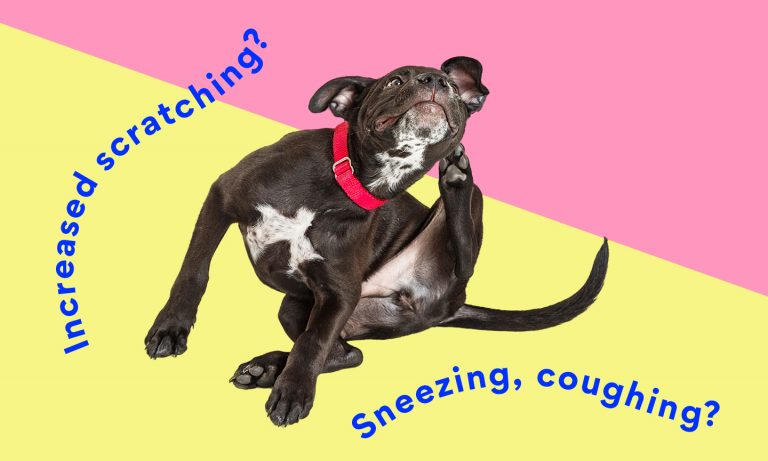You’re a pet lover, but it just so happens that you also have an allergic reaction to dogs or cats, or both! No one wants to give up their snuggly companions due to pet allergies. But what can be done to alleviate dog and cat allergy symptoms? If you’re one of those unlucky allergy sufferers with pets, here’s your 6-step plan for battling dog and cat allergies.
Step 1: Know the Cause of Dog and Cat Allergies
The first step in the fight against cat and dog allergies is knowing your foe. What exactly do people with pet allergies need to avoid—is it the fur or pet dander?
“Dander is found on just about every warm fuzzy critter out there, unfortunately,” says Kristen Vance, DVM and founder of Homeward Bound Mobile Vet in Bel Air, Maryland.
But it’s not just the hair or dander that causes allergies.
“Allergies aren’t caused by the hair or dander directly, but a protein in them that people are allergic to,” she says. “The protein can also be found in the urine and saliva.”
So, it’s not just petting a cat or dog that does it; you also have to watch out for those doggy kisses or grooming licks from your kitty.
Maybe you’re hoping to escape cat or dog allergy symptoms by going with a hypoallergic pet. Not so fast, says Dr. Tania Elliot, a leading allergist in New York City and chief medical officer of nationwide preventive health company EHE.
“There is no such thing as a hypoallergenic pet!” Dr. Elliot says. “Many people think animals that don’t shed are hypoallergenic, but people can be allergic to much more than just the fur, i.e., dander, skin cells and saliva.”
She adds that “Having a pet within the first year of life reduces the chance of developing pet allergies. In general, people get allergies through a combination of genetics (family history) and environmental factors.”
Step 2: Improve the Air Quality in Your Home
“Improving your overall air quality can be a big help to allergy sufferers,” according to Stevi Cicero, office manager of Rod Johnson Air Conditioning in Stockton, California. Cicero suggests changing your filters regularly and getting an air-quality monitor that measures airborne allergen levels.
“It will help you better understand the impact of leaving a window open, bathing your pet or other actions that could affect your allergies,” Cicero says. “You may also want to consider buying houseplants that improve indoor humidity and purify your home’s air.”
Several options for plant and pet lovers include non-flowering bamboo, Areca and Bamboo palms, Spider plants, African Violets, Florida Butterfly orchid, and non-toxic succulents (try out Blue Echeveria, Hens and Chickens (Echeveria elegans), Haworthia or Burrow’s Tail).
The allergists agree when it comes to air filters.
“Pet allergens are airborne and can stay suspended in the air for months,” Dr. Elliot says. “This is particularly true for cat allergen, which can stay in a room for up to four months after the pet is removed from the home.”
Dr. Vance advises clients with pet allergies to get a HEPA filter air purifier. “HEPA” stands for high-efficiency particulate air, and these types of filters must remove 99.97 percent of particles smaller than 0.3 microns to qualify as HEPA by U.S. government standards.
Step 3: Cut Down on the Pet Dander and Loose Fur
This step might not sound fun, but it’s necessary to keep dog dander and cat dander at a minimum. Dr. Vance recommends vacuuming a lot.
“It helps pick up that dander and hair and get it out of the environment,” Dr. Vance says.
Carpeting, curtains and rugs are magnets for pet fur, so your vacuuming routine should be even more frequent if you don’t have hard floors or non-fabric window coverings. Pet vacuums, like the Bissell Pet Hair Eraser, have special features that can help you get pet hair out from underneath furniture and remove it from carpeting.
Along with frequent vacuuming, be sure to wash your bedding, curtains and rugs, as well as your pet’s bed and blankets often.
Step 4: Wash Your Pets and Your Hands
Giving your pet a bath can also help with cat and dog allergy symptoms. This might be a tough one if you’ve never tried to get your pet into a bathtub or sink. It’s not impossible, even though your pet somehow knows what’s about to happen if you merely think about bathing them. For those who will tolerate a bath, the Booster Bath Elevated Grooming Center might be a good investment for frequent bathing.
“Wash your pet once a week,” Dr. Elliot says. “If they won’t stay, using wipes can be an alternative.”
Earthbath has hypoallergenic grooming wipes that can help remove dirt, dander, drool and odor from the coat without having to bathe your pet. And of course, remember to always wash your hands after petting an animal so you don’t end up rubbing your eyes or nose.
Step 5: Make the Bedroom a Pet-Free Zone
It might sound impossible for pet lovers, but if you usually have an allergic reaction to cats or dogs, consider making your bedroom a pet-free area. Dr. Elliot and Dr. Vance both agree that this is a good option for dealing with pet allergies.
Even with keeping pets out of the bedroom, airborne allergens might still find their way in. You can remove pet allergens from your carpet and furniture with Nature’s Miracle Deep Cleaning Carpet Shampoo.
Step 6: See an Allergist to Ask About Medications
Along with all of these precautions, perhaps the best advice is to see an allergist to determine a plan for treatment. To keep the sneezing and itchy nose, throat and ears from being a daily occurrence, Dr. Elliot says that “Allergy shots can cure people of their pet allergies and is your best bet if you are determined to keep your pet in the home.”
Whether you get them weekly or several times a week, you will receive an injection of the allergen that you are allergic to, and the dosage is gradually increased to build up your tolerance.
If you are unable to get allergy shots, Dr. Elliot points out that daily, routine medication is necessary, because untreated allergies run the risk of developing new allergies as well as asthma.
“Because the pets are with you all the time, as-needed medication is not the way to go,” Dr. Elliot says. “Once an allergic reaction starts, it’s much harder to get it under control, so daily nasal corticosteroids is first-line treatment.”
If you find that you’re allergic to dog saliva, cat saliva and pet dander, don’t give up on being a pet parent for good. Follow this checklist to help reduce your dog and cat allergy symptoms so you can get back to hanging out with your pack.

Nikki Naser, BeChewy Senior Editor
Instead of owning 30 cats, Nikki has an impressive collection of 30 cat-themed T-shirts, and just 4 pets—a ginger-haired senior cat, a senior Maine Coon, a middle-aged Choodle, and a young kitty who showed up one day on the back steps. A former Orlando resident, Nikki worked on several tourism publications before moving to South Beach. When she’s not stopping to take pics of community cats to post on Instagram, Nikki spends her time with the office pets at Chewy, writing for their BeChewy blog.
Featured Image: Chewy Studios
Share:













